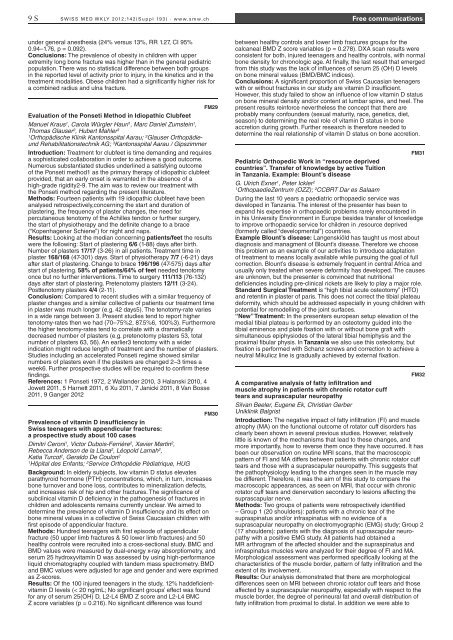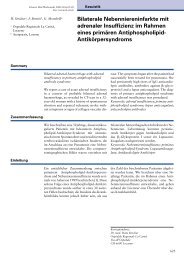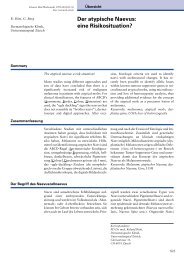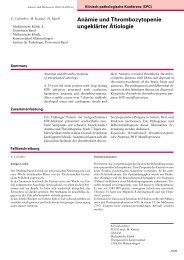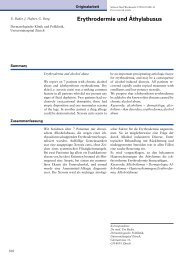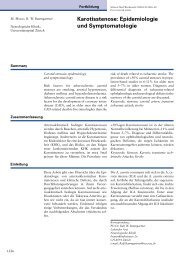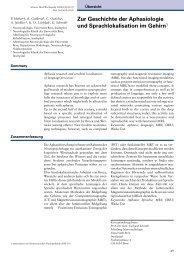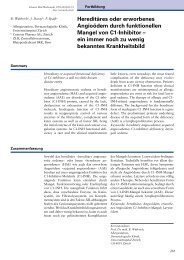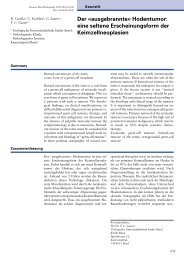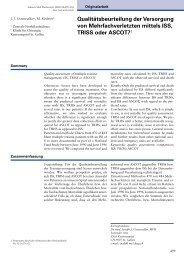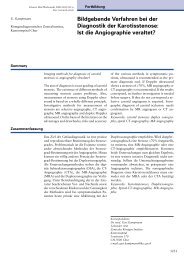SMW Supplementum 193 - Swiss Medical Weekly
SMW Supplementum 193 - Swiss Medical Weekly
SMW Supplementum 193 - Swiss Medical Weekly
Create successful ePaper yourself
Turn your PDF publications into a flip-book with our unique Google optimized e-Paper software.
9 S SWiSS Med Wkly 2012;142(Suppl <strong>193</strong>) · www.smw.ch Free communications<br />
under general anesthesia (24% versus 13%, RR 1.27, CI 95%<br />
0.94–1.76, p = 0.092).<br />
Conclusions: The prevalence of obesity in children with upper<br />
extremity long bone fracture was higher than in the general pediatric<br />
population. There was no statistical difference between both groups<br />
in the reported level of activity prior to injury, in the kinetics and in the<br />
treatment modalities. Obese children had a significantly higher risk for<br />
a combined radius and ulna fracture.<br />
FM29<br />
Evaluation of the Ponseti Method in Idiopathic Clubfeet<br />
Manuel Kraus1 , Carola Würgler Hauri1 , Marc Daniel Zumstein1 ,<br />
Thomas Glauser2 , Hubert Mahler3 1Orthopädische Klinik Kantonsspital Aarau; 2Glauser Orthopädieund<br />
Rehabilitationstechnik AG; 3Kantonsspital Aarau / Gipszimmer<br />
Introduction: Treatment for clubfeet is time demanding and requires<br />
a sophisticated collaboration in order to achieve a good outcome.<br />
Numerous substantiated studies underlined a satisfying outcome<br />
of the Ponseti method1 as the primary therapy of idiopathic clubfeet<br />
provided, that an early onset is warranted in the absence of a<br />
high-grade rigidity2-9. The aim was to review our treatment with<br />
the Ponseti method regarding the present literature.<br />
Methods: Fourteen patients with 19 idiopathic clubfeet have been<br />
analysed retrospectively,concerning the start and duration of<br />
plastering, the frequency of plaster changes, the need for<br />
percutaneous tenotomy of the Achilles tendon or further surgery,<br />
the start of physiotherapy and the definite change to a brace<br />
(“Kopenhagener Schiene”) for night and naps.<br />
Results: Looking at the median concerning patients/feet the results<br />
were the following: Start of plastering 6/6 (1-88) days after birth.<br />
Number of plasters 17/17 (3-26) in all patients. Treatment time in<br />
plaster 168/168 (47-301) days. Start of physiotherapy 7/7 (-6-21) days<br />
after start of plastering. Change to brace 196/196 (47-575) days after<br />
start of plastering. 58% of patients/64% of feet needed tenotomy<br />
once but no further interventions. Time to surgery 111/113 (76-132)<br />
days after start of plastering. Pretenotomy plasters 12/11 (3-24).<br />
Posttenotomy plasters 4/4 (2-11).<br />
Conclusion: Compared to recent studies with a similar frequency of<br />
plaster changes and a similar collective of patients our treatment time<br />
in plaster was much longer (e.g. 42 days5). The tenotomy-rate varies<br />
in a wide range between 3. Present studies tend to report higher<br />
tenotomy-rates then we had (70–75%2, 87.5%6, 100%3). Furthermore<br />
the higher tenotomy-rates tend to correlate with a dramatically<br />
decreased number of plasters (e.g. pretenotomy plasters 53, total<br />
number of plasters 63, 56). An earlier3 tenotomy with a wider<br />
indication might reduce length of treatment and the number of plasters.<br />
Studies including an accelerated Ponseti regime showed similar<br />
numbers of plasters even if the plasters are changed 2–3 times a<br />
week6. Further prospective studies will be required to confirm these<br />
findings.<br />
References: 1 Ponseti 1972, 2 Wallander 2010, 3 Halanski 2010, 4<br />
Jowett 2011, 5 Harnett 2011, 6 Xu 2011, 7 Janicki 2011, 8 Van Bosse<br />
2011, 9 Ganger 2012<br />
FM30<br />
Prevalence of vitamin D insufficiency in<br />
<strong>Swiss</strong> teenagers with appendicular fractures:<br />
a prospective study about 100 cases<br />
Dimitri Ceroni1 , Victor Dubois-Ferrière2 , Xavier Martin2 ,<br />
Rebecca Anderson de la Llana2 , Léopold Lamah2 ,<br />
Katia Turcot2 , Geraldo De Coulon2 1Hôpital des Enfants; 2Service Orthopédie Pédiatrique, HUG<br />
Background: In elderly subjects, low vitamin D status elevates<br />
parathyroid hormone (PTH) concentrations, which, in turn, increases<br />
bone turnover and bone loss, contributes to mineralization defects,<br />
and increases risk of hip and other fractures. The significance of<br />
subclinical vitamin D deficiency in the pathogenesis of fractures in<br />
children and adolescents remains currently unclear. We aimed to<br />
determine the prevalence of vitamin D insufficiency and its effect on<br />
bone mineral values in a collective of <strong>Swiss</strong> Caucasian children with<br />
first episode of appendicular fracture.<br />
Methods: Hundred teenagers with first episode of appendicular<br />
fracture (50 upper limb fractures & 50 lower limb fractures) and 50<br />
healthy controls were recruited into a cross-sectional study. BMC and<br />
BMD values were measured by dual-energy x-ray absorptiometry, and<br />
serum 25 hydroxyvitamin D was assessed by using high-performance<br />
liquid chromatography coupled with tandem mass spectrometry. BMD<br />
and BMC values were adjusted for age and gender and were exprimed<br />
as Z-scores.<br />
Results: Of the 100 injured teenagers in the study, 12% haddeficientvitamin<br />
D levels (< 20 ng/mL; No significant groups’ effect was found<br />
for any of serum 25(OH) D, L2-L4 BMD Z score and L2-L4 BMC<br />
Z score variables (p = 0.216). No significant difference was found<br />
between healthy controls and lower limb fractures groups for the<br />
calcaneal BMD Z score variables (p = 0.278). DXA scan results were<br />
consistent for both, injured teenagers and healthy controls, with normal<br />
bone density for chronologic age. At finally, the last result that emerged<br />
from this study was the lack of influences of serum 25 (OH) D levels<br />
on bone mineral values (BMD/BMC indices).<br />
Conclusions: A significant proportion of <strong>Swiss</strong> Caucasian teenagers<br />
with or without fractures in our study are vitamin D insufficient.<br />
However, this study failed to show an influence of low vitamin D status<br />
on bone mineral density and/or content at lumbar spine, and heel. The<br />
present results reinforce nevertheless the concept that there are<br />
probably many confounders (sexual maturity, race, genetics, diet,<br />
season) to determining the real role of vitamin D status in bone<br />
accretion during growth. Further research is therefore needed to<br />
determine the real relationship of vitamin D status on bone accretion.<br />
FM31<br />
Pediatric Orthopedic Work in “resource deprived<br />
countries”. Transfer of knowledge by active Tuition<br />
in Tanzania. Example: Blount’s disease<br />
G. Ulrich Exner1 , Peter Ickler2 1OrthopaedieZentrum (OZZ); 2CCBRT Dar es Salaam<br />
During the last 10 years a paediatric orthopaedic service was<br />
developed in Tanzania. The interest of the presenter has been to<br />
expand his expertise in orthopaedic problems rarely encountered in<br />
in his University Environment in Europe besides transfer of knowledge<br />
to improve orthopaedic service for children in ‚resource deprived<br />
(formerly called “developmental”) countries.<br />
Example Blount’s disease: Langenskiöld has taught us most about<br />
diagnosis and managment of Blount’s disease. Therefore we choose<br />
this problem as an example of our activities to introduce adaptation<br />
of treatment to means locally available while pursuing the goal of full<br />
correction. Blount’s disease is extremely frequent in central Africa and<br />
usually only treated when severe deformity has developed. The causes<br />
are unknown, but the presenter is convinced that nutritional<br />
deficiencies including pre-clinical rickets are likely to play a major role.<br />
Standard Surgical Treatment is “high tibial acute osteotomy” (HTO)<br />
and retentin in plaster of paris. This does not correct the tibial plateau<br />
deformity, which should be addressed especially in young children with<br />
potential for remodelling of the joint surfaces.<br />
“New” Treatment: In the presenters european setup elevation of the<br />
medial tibial plateau is performed by an osteotomy guided into the<br />
tibial eminence and plate fixation with or without bone graft with<br />
simultaneous epiphysiodes of the lateral tibial hemiphysis and the<br />
proximal fibular physis. In Tanzania we also use this osteotomy, but<br />
fixation is performed with Schanz screws and correction to achieve a<br />
neutral Mikulicz line is gradually achieved by external fixation.<br />
FM32<br />
A comparative analysis of fatty infiltration and<br />
muscle atrophy in patients with chronic rotator cuff<br />
tears and suprascapular neuropathy<br />
Silvan Beeler, Eugene Ek, Christian Gerber<br />
Uniklinik Balgrist<br />
Introduction: The negative impact of fatty infiltration (FI) and muscle<br />
atrophy (MA) on the functional outcome of rotator cuff disorders has<br />
clearly been shown in several previous studies. However, relatively<br />
little is known of the mechanisms that lead to these changes, and<br />
more importantly, how to reverse them once they have occurred. It has<br />
been our observation on routine MRI scans, that the macroscopic<br />
pattern of FI and MA differs between patients with chronic rotator cuff<br />
tears and those with a suprascapular neuropathy. This suggests that<br />
the pathophysiology leading to the changes seen in the muscle may<br />
be different. Therefore, it was the aim of this study to compare the<br />
macroscopic appearances, as seen on MRI, that occur with chronic<br />
rotator cuff tears and denervation secondary to lesions affecting the<br />
suprascapular nerve.<br />
Methods: Two groups of patients were retrospectively identified<br />
– Group 1 (20 shoulders): patients with a chronic tear of the<br />
supraspinatus and/or infraspinatus with no evidence of a<br />
suprascapular neuropathy on electromyographic (EMG) study; Group 2<br />
(17 shoulders): patients with the diagnosis of suprascapular neuropathy<br />
with a positive EMG study. All patients had obtained a<br />
MR arthrogram of the affected shoulder and the supraspinatus and<br />
infraspinatus muscles were analyzed for their degree of FI and MA.<br />
Morphological assessment was performed specifically looking at the<br />
characteristics of the muscle border, pattern of fatty infiltration and the<br />
extent of its involvement.<br />
Results: Our analysis demonstrated that there are morphological<br />
differences seen on MRI between chronic rotator cuff tears and those<br />
affected by a suprascapular neuropathy, especially with respect to the<br />
muscle border, the degree of perineural fat and overall distribution of<br />
fatty infiltration from proximal to distal. In addition we were able to


